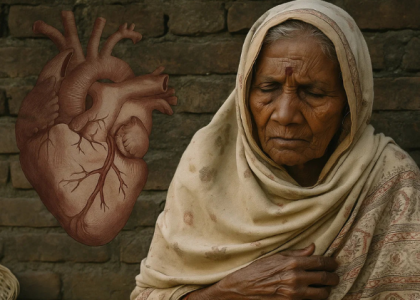The Forgotten Cause of Heart Failure: Rheumatic Heart Disease
In many parts of South Asia, a simple sore throat can quietly lead to serious heart problems years later. It’s called rheumatic heart disease — and it’s more common than you think.
While we often talk about diabetes, high blood pressure, and cholesterol as heart risk factors, this older threat continues to affect millions of South Asians. Most concerning? Many people living with it don’t even know they have it.
Let’s explore this “forgotten” cause of heart failure and why it matters for our families.
What Is Rheumatic Heart Disease?
Rheumatic heart disease (RHD) starts with something as simple as a sore throat. When a child gets a specific type of throat infection called strep throat (caused by streptococcal bacteria), and it’s not treated with antibiotics, the body’s immune system sometimes reacts in an unusual way.
This reaction can lead to rheumatic fever — a condition that causes:
- Fever
- Joint pain and swelling
- A specific rash
- And most importantly, inflammation of the heart
Think of the heart valves like doors that open and close to control blood flow. Rheumatic fever makes these doors stiff or leaky — so blood doesn’t flow the way it should. According to the World Health Organization (WHO), this damage can worsen over time, even years after the original infection is gone.
Important to know: The time between strep throat and heart valve damage can be so long (often many years) that people rarely connect their childhood illnesses with their adult heart problems.
Why It Still Affects Millions in South Asia
According to The Lancet, South Asia has some of the highest rates of rheumatic heart disease in the world. The Indian Council of Medical Research (ICMR) estimates that over 2 million people in India alone suffer from RHD.
Why does it persist when it’s largely disappeared in wealthier countries?
- Poor access to healthcare: Many children with sore throats never receive antibiotics that could prevent rheumatic fever
- Crowded living conditions: Strep throat spreads easily in crowded homes and schools
- Lack of screening programs: Without regular heart check-ups, early valve damage goes undetected
- No follow-up care: Even when diagnosed, many patients can’t afford regular monitoring or treatment
- Low awareness: Many people don’t know that recurring sore throats need medical attention
Most heartbreaking is that RHD is almost entirely preventable with proper treatment of strep throat infections.
Signs That Someone May Have RHD
Many people with rheumatic heart disease don’t know they have it until the damage is advanced. Here are symptoms to watch for:
- Breathlessness or fatigue during normal activities
- Swollen legs or ankles, especially in the evening
- Irregular heartbeat or heart palpitations
- Chest pain that might come and go
- Fainting or dizziness, especially during activity
- Unusual tiredness that doesn’t improve with rest
A key clue: Many people are diagnosed only in their 30s, 40s, or later — when they mention to a doctor that they had frequent fevers or joint pains as a child.
The American Heart Association notes that many heart failure cases are misdiagnosed when doctors don’t consider RHD as a possible cause.
How It Leads to Heart Failure
When heart valves are damaged, they either:
- Don’t close properly (causing leakage or “regurgitation”)
- Don’t open fully (causing blockage or “stenosis”)
Either way, the heart must work much harder to pump the same amount of blood. Over time, this extra workload causes:
- Heart enlargement – the heart muscle stretches and thins
- Weakened pumping ability – the heart can’t contract as strongly
- Fluid buildup in the lungs and body
- Eventual heart failure – when the heart can no longer meet the body’s needs
A study published in Circulation: Heart Failure shows that in South Asia, RHD remains one of the leading causes of heart failure, particularly among women and those from rural areas.
What Families Should Do
If you have South Asian heritage, here are important steps to take:
- For your immediate family: Ask older relatives if they had frequent fevers, joint pains, or heart murmurs in childhood. Mention your South Asian background to your doctor. Request an echocardiogram (heart ultrasound) if there are any symptoms of heart valve problems. Be vigilant about treating strep throat in children with a full course of antibiotics.
- If you have family in South Asia: Encourage sore throat treatment with proper antibiotics. Suggest heart screening for anyone with a history of rheumatic fever. Share information about the connection between childhood strep infections and adult heart problems.
- For those already diagnosed with RHD: Regular medical follow-ups are crucial, even when feeling well. Take prescribed medications consistently. Discuss surgical options if valve damage is severe.
Hope Through Prevention
The good news? Rheumatic heart disease is largely preventable, and even when present, it can be managed with proper care.
Recent initiatives across South Asia are making progress:
- School screening programs in parts of India and Nepal
- Community health workers trained to recognize symptoms
- Mobile technology for treatment tracking
- Advanced surgical techniques restoring quality of life
According to WHO, with appropriate awareness and access to healthcare, we could virtually eliminate new cases of rheumatic heart disease in a generation.
Spreading Awareness Saves Lives
Rheumatic heart disease may be a “forgotten” cause of heart failure in modern discussions, but for millions of South Asians, it remains a daily reality.
By understanding this condition and sharing information with our families, we can help protect the next generation from this preventable form of heart disease.
Remember: A simple sore throat should never lead to lifelong heart problems. With proper education and healthcare access, we can change this story for South Asian communities worldwide.
Sources: World Health Organization, The Lancet, Indian Council of Medical Research, American Heart Association, Circulation: Heart Failure.




